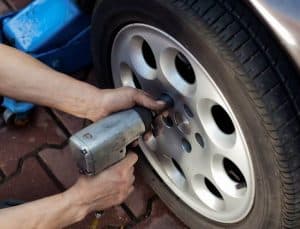It’s the wish of all car owners to have a trouble-free drive every day. However, once you realize that there’s something unusual with your vehicle, it’s impossible to concentrate. You need to understand that your vehicle’s tires are the only components that have direct contact with the road.
Therefore they are not in good working condition; the overall performance of the vehicle would be ruined. Now, how can you spot the symptoms of a rear tire that needs balancing? This article will help you with essential information to immediately seek an expert’s help when you spot such signs.
Spotting symptoms of imbalance rear tire
Imbalance rear tires are associated with faster wear and tear. So, if you delay working on the issue, you might end up spending more. What you need is to always be aggressive and on the lookout to spot any imbalance tire sign. Remember, the earlier, the better.
To get the best from your car, you have to ensure its tires are properly balanced and aligned. Tire balancing involves adjusting the weight of your car around the tires. On the other hand, wheel alignment means wheel angle against the ground.
Below are some of the common symptoms of rear tires that need balancing:
1. Irritating tire noise
Apart from vibrations, there’s nothing else that makes a driver/car owner more devastated than moving around with irritating tire noises. You will realize something is not right with your vehicle because the noises weren’t there in the first place. Therefore, if you hear a humming or buzzing noise that accompanies vibrations, and then your vehicle could be surviving on unbalanced tires.
Besides, try to be on the lookout and observe if the tire noise is persistent when you accelerate. Balancing will be a great solution to such an issue for your rear tires to work properly. Seek the help of an expert before worsening the issue; you could spend more on tire replacement.
2. Too much tire vibration
Sometimes you hear people at your vehicle’s back seat complaining about vibrating seats. Some people think that vibration affects only the steering wheel; no, if your rear tires are unbalanced, expect irritating vibrations.
Wheel balancing mostly affects wheel steering, vibrating too much in that you can feel them when accelerating. It will veer off immediately after you leave the steering for a while. However, when this vibration issue is too much on the rear tires, know that your tires require balancing.
Balance the tires to allow your passengers on the back seats to also enjoy the ride. Unfortunately, even the driver won’t get away with too many vibrating tires; you’ll be unsettled. Persistent tire imbalance, the tires will wear down faster, the whole cabin of your vehicle will be increased and affected.
Remember, other problems can trigger vibrations, such as wheel assembly issues or damaged tires. It’s therefore advisable to get the car diagnosed to be sure about the problem.
3. Steering issues
The easiest way to spot an unbalanced rear tire issue is through the steering wheel nature. You will feel uncomfortable with unbalanced tires, leading to an unresponsive and difficult steering wheel. The wheel takes time to respond to the command; if at high speed can lead to accidents.
Additionally, it won’t be easy to turn the steering smoothly in your desired direction. Therefore controlling the vehicle will be a massacre, fighting you back when trying to turn the vehicle in the intended direction. Experts advise that your vehicle is diagnosed with this problem immediately after experiencing issues with the steering wheel.
4. Unusual fuel consumption
Since the vehicle will be struggling to move, fuel consumption will be unrealistic. What you need to understand is that unbalanced rear tires put more stress on your car’s engine. This is because the unbalanced forces’ resistance makes the engine struggle to push the vehicle.
The engine will therefore have to use more energy to keep the car in motion. So, it will end up consuming more fuel for constant operation, especially with imbalanced rear tires. Once your vehicle starts consuming more gas and the fuel goes faster than expected, get your tires checked for an imbalance issue.
Remember, sometimes inflated car tires can also lead to more fuel consumption than usual. But, if the tire pressure levels are normal, then the remaining problem is the unbalanced tire issue. You need to often inspect your car’s fuel economy to determine whether the tires are not balanced.
Try to figure out the gallons used to complete a certain mile. Don’t only depend on the fuel miter gauge that most modern cars come with. It can mislead you; do it manually and compare it with previous fuel economy.
5. Bad bearings and shocks
Some wheel assembly parts like shocks, bearings, and springs can’t work properly when the rear tires aren’t balanced. They will start experiencing higher wear, leading to out-of-balance rear tires. Failure to fix this issue on time, you might end up spending more on extensive replacement or repair later on.
So, once you start experiencing some dry bearings and unsettled shocks, get the vehicle to diagnose.
6. Uneven tire wear
Unbalanced rear tires sometimes may portray uneven tire wear. Experts recommend that it’s advisable to observe your tire treads and spot where wearing is taking place. After carrying a deep observation and see the tire wear is not uniform, unbalanced rear tires might be the problem.
So, tread wear is in a good position to notify you a lot concerning how well or bad your rear tire is. Uneven tire tread might be a result of steering and wheel issues.
Abnormal tire wearing puts your vehicle at a higher risk of moving around with flat rear tires; hence their wearing won’t be uniform. This can make the tires thin completely, leading to a sudden rupture. This is dangerous, especially when it occurs while driving.
For this reason, the experts recommend tire rotation to enhance uniform tire wear. Once the out-of-balance rear tire issue is fixed, the tires will be in good condition, and uniform tread wear. Weight or pressure is not distributed uniformly when the rear tires are unevenly worn out.
You Might be interested to read also: Balance My Tires Before Alignment?
7. Pressure imbalances
Pressure imbalances might be another cause for out-of-balance rear tires. If you realize that one of your rear tires is getting inflated, your driving experience will be unbalanced. If you drive for a while without fixing the pressure discrepancy, you will have to get your rear tires balanced when you add pressure.
8. The vehicle won’t even sit on the road
From the introductory part, I remember putting it clear that your car tires play a vital role because they directly connect the road and the vehicle. So, if one of them is not at the correct angle, the car’s whole shape will be affected.
Therefore, sometimes it is important to park your car in a straight posture and inspect it. If the rear tires are unbalanced, the entire body shape of the vehicle will be awkward.
Frequently asked questions:
- What happens when I drive on unbalanced rear tires?
Continued use of a car with unbalanced tires can transfer the problem to other components of the vehicle. Driving with unbalanced tires exerts undue stress on the vehicle’s parts like bearings, shocks, wheel assembly, and springs. Additionally, your car will start to consume more fuel, the engine struggling to move the vehicle.
- Should I balance my car’s rear tires?
If you experience the back seats, you could be likely driving an unbalanced rear tire. The seats tend to vibrate, giving you an unsettled driving experience. Balancing rear tires is therefore inevitable; don’t concentrate only on the front ones. Besides, if the wheels are not properly torqued, your car may keep on vibrating; are you ready for such a devastating driving experience?
- How do rear tires get unbalanced?
Tire deflation is caused by cold due to the way air particles in the tire contract. This turns to be abnormal when the car tire deflates too much, making them unbalanced. More so, reduced wheel weight is another reason that can lead to imbalanced tires.
- My car keeps on wobbling; what could be the problem?
Unbalanced tires and bent wheels are the most common reasons for vehicle wobbles. You are likely to hear wobbling when you step on the fuel pedal. So, you need to make sure that your vehicle’s tires are balanced before diagnosing other issues. Professional mechanics can do this service for you.
Final words
Even though tires must wear out, let the wearing be uniform; taking care of tires is difficult. Even small problems or imperfections may be feeling like a big issue and defects on your driving experience. This is the major reason to ensure that your vehicle’s weight is evenly distributed and tires are balanced.
Balancing is necessary to prolong the tires’ lifespan and enhance additional safety. The above article should help you notice and prevent the symptoms and signs of rear tires out of balance.
for more information about Rear tire out of balance symptoms, Watch this video below;
